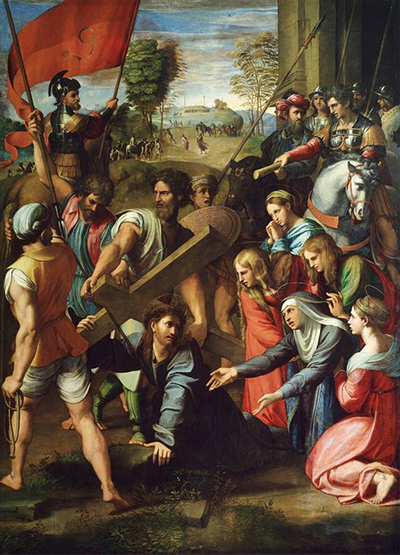The Fall on the Road to Calvary by Raphael is a painting that's considered as an important work for his style's development. It is now in the main Spanish national art museum called Museo del Prado, which is located in Madrid.
Santa Maria dello Spasimo, the Sicilian monastery, commissioned the panel in Palermo. It was painted around 1517 in Rome and shipped by sea. The ship transporting the painting had a troubled trip and ultimately sank. Vasari narrated that episode stating that as it was being transported to Palermo by sea, a great storm cast the ship against a rock. The ship was torn to pieces; the crew lost everything, except Raphael's Fall on the Road to Calvary, which was carried by sea to Genoa Italy. It was drawn to the shore and looked like a divine item. It was well taken care of and was found undamaged: even the waves and winds in their fury respected the beauty of this work.
The news about this story spread abroad, and the Sicilian monks tried to recover the miraculous picture. The monks had to ask the Pope to intervene to retrieve the painting. It was then taken to Sicily (an autonomous region of Italy) and placed in Palermo, a city of Southern Italy, where it got great fame. In the year 1661, Ferrando de Fonseca, the Spanish Viceroy acquired the painting on behalf of Philip IV of Spain, who wanted the picture to be placed on the main Royal Alcazar of Madrid altarpiece chapel. From 1813-1822, it stayed in Paris as it was among the paintings that Napoleon (French statesman and military leader) took as booty at the time of his war campaigns.
While it was still there, the picture was transferred to canvas, which is a practice that was adopted in France at that time. The painting was then returned and eventually re-integrated into the Royal Collection of Spain. Later, it was transferred to Prado. The painting shows the common subject where Christ is Carrying a Cross to his crucifixion when he fell and Mary, his mother, experiences a spasm of agony, Lo Spasimo or the Swoon of the Virgin. All the emotion of this picture is densely packed into the picture's foreground; the background is the same as that of a stage that's set with separate groups of people as well as crosses.
In the painting, the man who is on the left side, in the foreground, is the same as a figure in the painting by Raphael called The Judgement of Solomon, which can be found in the four Raphael Rooms, in the Palace of Vatican, except it is reversed. Simon of Cyrene is seen momentarily lifting Christ’s cross and looks at the guards in a serious manner. On the right side, the 4 Marys are depicted and guards are towering on both sides of the composition. The idea of devotion to the Virgin spasm was fashionable (if somehow controversial) in the early sixteenth century Catholicism, but in this picture, the Virgin has just fallen to her knees: she hasn't fainted or collapsed, as it's often shown.




